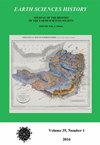城市热岛的成因、模拟与缓解:综述
IF 0.6
4区 哲学
Q4 GEOSCIENCES, MULTIDISCIPLINARY
引用次数: 2
摘要
城市化导致植被损失,并将透水区域转化为建筑和不透水区域,因此,与周围的农村地区相比,城市地区暴露的温度更高,这被称为城市热岛(UHI)。城市热岛影响城市环境,并导致与热有关的疾病和死亡率在过去几个世纪有所增加。考虑到全民健康保险问题的严重性,已经进行了大量的研究,并有广泛的文献可获得。本文综述了热岛的成因、建模和缓解战略。城市基础设施和人为热源是城市热岛发展的主要驱动因素。包括观测和建模技术在内的许多方法被用于了解热岛的形成、原因和缓解。城市热岛的形成和成因在很大程度上取决于城市的规模、形状和城市基础设施以及气候条件。虽然采用了各种建模技术来研究城市热岛,但在所有模型中仍然缺乏精确地表示物理现象和复杂的城市基础设施。许多研究审查了许多缓解热岛问题的战略,而增加城市植被是一种更有利于环境的解决办法。该研究总结了不同模拟技术和热岛热岛缓解措施的重要特点和局限性。本研究还确定了研究差距,并提出了进一步研究的领域。本文章由计算机程序翻译,如有差异,请以英文原文为准。
Causes, Modeling and Mitigation of Urban Heat Island: A Review
Urbanization leads to loss of vegetation and converting pervious areas into built-up and impervious areas, and consequently, urban areas expose higher temperatures as compared to surrounding rural areas, which is called Urban Heat Island (UHI). The UHI affects the urban environment and causes heat-related diseases and mortality that have increased over the last centuries. Considering the severity of the UHI problem, enormous research has been conducted and an extensive range of literature is available on this topic. This paper reviews the causes, modelling and mitigation strategies of the UHI. The urban infrastructure and anthropogenic heat sources are the main driving factors in developing the UHI in cities. Many approaches including observation and modelling techniques are used to understand the formation, causes and mitigation of the UHI. The formation and causes of the UHI largely depend on the size, shape and urban infrastructure of the cities as well as climatic conditions. Although various modelling techniques are used to study UHI, there are still lacks in all models to precisely represent the physical phenomena and complex urban infrastructure. Many UHI mitigation strategies are examined by numerous studies, while the increased urban vegetation is a more environmentally friendly solution. The study summarizes the important features and limitations of different modelling techniques and mitigation measures of the UHI. This study also identifies research gaps and proposes areas for further research.
求助全文
通过发布文献求助,成功后即可免费获取论文全文。
去求助
来源期刊

Earth Sciences History
GEOSCIENCES, MULTIDISCIPLINARY-HISTORY & PHILOSOPHY OF SCIENCE
CiteScore
1.00
自引率
0.00%
发文量
1
审稿时长
>12 weeks
期刊介绍:
Earth Sciences History promotes and publishes historical work on all areas of the earth sciences – including geology, geography, geophysics, oceanography, paleontology, meteorology, and climatology.
The journal honors and encourages a variety of approaches to historical study: biography, history of ideas, social history, and histories of institutions, organizations, and techniques.
Articles are peer reviewed.
 求助内容:
求助内容: 应助结果提醒方式:
应助结果提醒方式:


